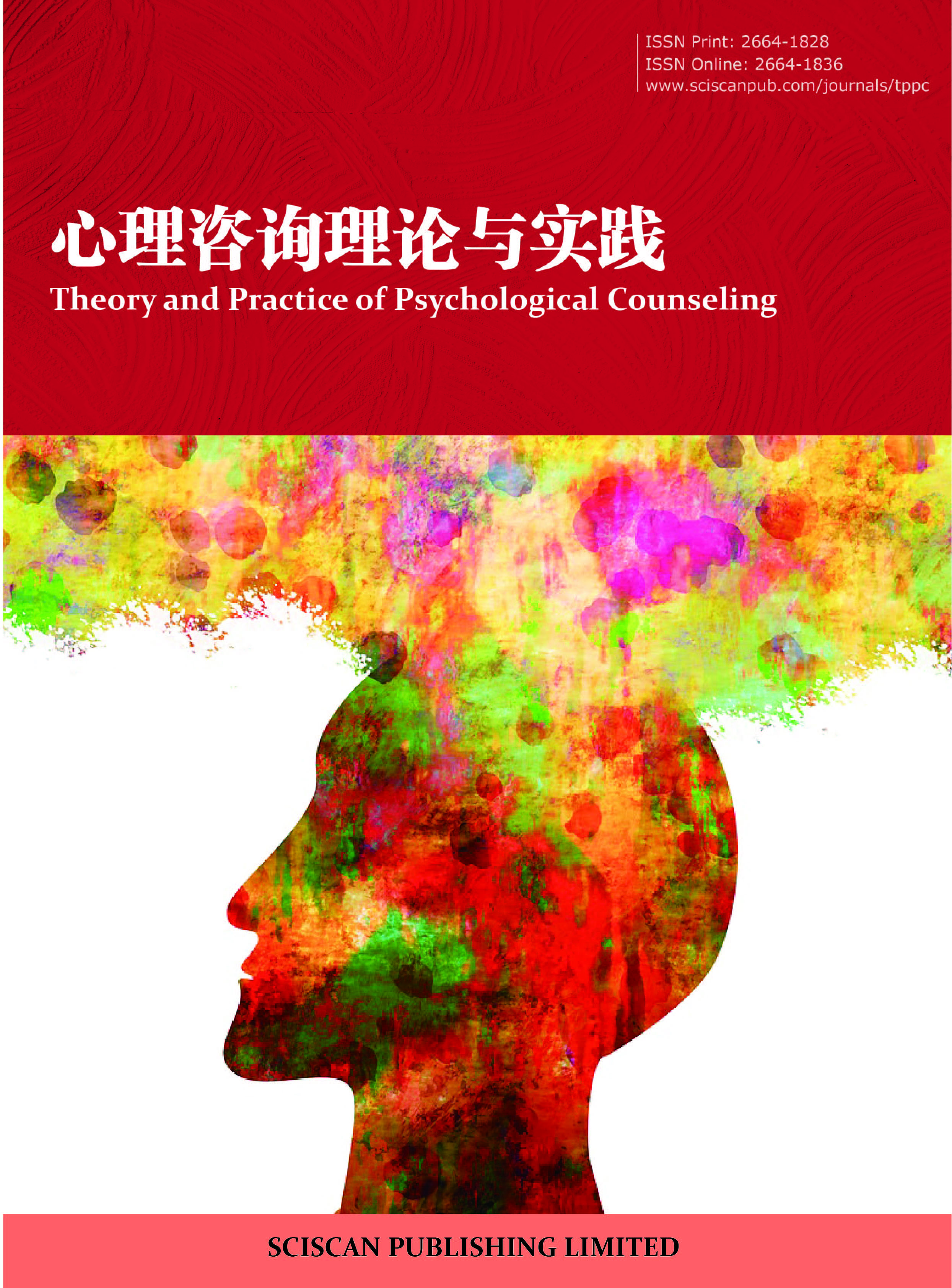Theory and Practice of Psychological Counseling
表达性艺术治疗视阈下曼陀罗与警察创伤干预匹配研究
Research for the Compatibility of Mandala and Police Trauma Intervention in a Perspective of Expressive Arts Therapy
- Authors: 靳晓峰¹ 肖志华² 吴瑕³ 汤芙蓉¹
-
Information:
1. 四川警察学院警察管理系,泸州; 2. 四川警察学院心理健康中心,泸州; 3. 四川警察学院基础教学部,泸州
-
Keywords:
Expressive arts therapy; Mandala; Police; Trauma表达性艺术治疗; 曼陀罗; 警察; 创伤
- Abstract: Expressive arts therapy (EAT) is a significant means of trauma intervention, which has beckoned much attention. As an EAT, mandalas have a unique advantage in trauma intervention. The creation is a process of personal healing, specifically manifested in the fact that the individual's internal trauma experience can be externalized through metaphoric means such as graphics, lines, sizes, and colors, to alleviate the discomfort directly caused by trauma exposure. Moreover, the Mandala is committed to the psychosomatic healing and integration of individuals from the beginning to the end, and it adopts symbolic methods to stimulate the creator's introspection and self-observation to actively facilitate the restoration of the relationship, which is highly consistent with the characteristics of police trauma. Embracing mandalas in police trauma intervention can provide theoretical support and empirical guidance for the latter, thereby enhancing their professional sense of belonging and happiness. 表达性艺术治疗是进行创伤干预的重要手段,一直以来备受关注。曼陀罗作为其中一员,在创伤干预中具有独特的优势。其创作本身即为个体疗愈的过程,具体表现在个体的内在创伤体验可以通过图形、线条、大小、颜色等隐喻形式外化,以此减少创作者由于创伤直接暴露而造成的不适。再有,曼陀罗从始至终致力于实现个体身心的疗愈与整合,同时采用象征的手法激发创作者的内省与自我体察,在此基础上积极促成关系的修复。这些与警察创伤的特点有很高的契合度。将曼陀罗纳入警察创伤干预策略之中,可以为后者提供理论支撑与实证引导,由此提升其职业归属感和幸福感。
- DOI: https://doi.org/10.35534/tppc.0603013
- Cite: 靳晓峰,肖志华,吴瑕,等.表达性艺术治疗视阈下曼陀罗与警察创伤干预匹配研究[J].心理咨询理论与实践,2024,6(3):100-108.
1 引言
警察是一个在工作过程中经常遭遇创伤情境的群体[1][2],执法过程中经历的应激与创伤会对该群体幸福和健康造成持久的负面影响[1]。此外,延迟、慢性、持续地暴露于潜在的创伤事件可能会导致警察健康和幸福的损耗[3][4][5][6]。然而,对于遭受创伤的警察群体,其普遍存在对于心理救助的污名化倾向[7][8],导致罹患PTSD的警察倾向于将自己看成是脆弱的、易受伤害的和无能的。污名化的唤醒使其惯于将世界看成是极端危险的,并在自罪的同时因为自身的创伤反应而感到羞愧[9],由此导致警察长期拒绝介入心理干预[1]。再有,警察通常诉诸于与身体健康无益但可临时充当“安慰剂”的压力应对方式(如酗酒、回避)作为消解极端应激与创伤的手段[10][11][12][13][5],加之其经常采用各种心理防御机制(如压抑、替代、隔离、幽默)回避创伤和应激带来的负面影响[14][15],于是不断陷入一个由下列三要素所构成的恶性循环,即“职业创伤与应激”“对创伤情绪与记忆的不当应对”,与“心理与生理健康的恶化”[16]。不难看出,上述诸多原因使得警察创伤反应愈发凸显。
鉴于警察群体创伤现状带来的困境,采用一种高效的干预手段“绕过”其心理防御机制,取而代之采用象征的手段暴露当事人问题存在的症结,显得极有必要。该方法一方面应表达出警察的创伤样貌,另一方面应最低程度降低创伤呈现对其造成的负面影响。在这些综合的考量下,表达性艺术治疗成为现阶段应用于该群体的绝佳选择。
2 表达性艺术治疗与创伤干预
表达性艺术治疗(Expressive Arts Therapy,EAT)于1942年由英国艺术家Adrian Hill引入心理治疗领域,随后于1960年成为独立的心理治疗方法[17],主要包含视觉艺术、音乐艺术、戏剧艺术、肢体舞动艺术、想象性文字等形式。EAT的实施者不必是艺术家,相反,只要是致力于对自我进行探索,努力寻找内在问题症结的个体均可以通过这种方式表达自我,最主要是保持开放的态度和足够的创造力。从功能上来看,EAT旨在引导各年龄段个体通过不同发展阶段的解释和展示在艺术的框架结构下更好地了解自身潜意识。作为引导艺术创作者终生表达内部冲突、创伤的有力工具,EAT得到了广泛的推广与使用[18]。另一方面,EAT可以帮助个体通过绘画等艺术形式外化想法与情绪[19],同时将自身无法通过语言表达的深层情绪与冲突以图像的形式显现出来[20]。Kramer(1993)认为,虽然EAT不能解决由自性(Self)所产生的深层情绪混乱,但是其在加速个体宣泄和降低内在冲突上无与伦比,缘自其可以在一个被社会所接受的层面上帮助个体宣泄诸如愤怒、敌意等毁灭性能量[21]。此外,EAT可以增强来访者的创造力,同时提高其情绪与认知的恢复,改善社会功能以及提高生活质量。
对于内向个体、不擅长表达自身情绪与情感的个体,以及述情障碍(Alexithymia)个体,EAT可以帮助他们借助外部的艺术形式,如绘画等表达自身的情绪与情感。警察隶属于上述群体,另外,其职业的特殊性使之形成了类似军队的亚文化,如“愤世嫉俗”“兄弟情”“传统”“工作取向”和“心理健康污名”[22]。“心理健康污名”是“心理救助污名”的别称,该种偏见导致特定群体避免谈论令自己感到悲伤的事件,因为这样做会使其认为自己是靠不住的、不胜任的,由此回避对于自我的探索。值得说明的是,EAT却可以帮助个体在有限的时间内将潜意识的信息以非言语的、较少阻碍的形式呈现出来并促成真实信息的收集,从而通过“绕过”创作者心理防御的方式达到直接找到问题症结的目的。另有,当个体情绪超负荷的情况下,EAT可以将情绪主体的创伤记忆转移到当下的创作活动中来,由此促成创作者再次实现身心的平衡[23]。
3 曼陀罗与创伤干预
3.1 曼陀罗
以EAT中曼陀罗(Mandala)为例,其是由精神分析学派卡尔·荣格发展并完善的非言语心理治疗手段。该方法建立在投射、表达、象征、升华、外化等心理防御机制的基础之上,也叫“曼荼罗”“坛”“坛城”“轮圆具足”等。曼陀罗的叫法最初来自于古梵文,意指“圆”,其中“manda”指代“精华”,而“la”意为“拥有”。曼陀罗作为一种符号,代表了生命的完整,以及人类与其他生物乃至周围环境共存的内部联结[24]。荣格一度将曼陀罗的几何结构看作是梦境的象征符号,后者代表了梦者对于追求统一和完整的追寻[25],由此进一步凸显了曼陀罗与潜意识的纽带联结。
3.2 曼陀罗的创伤干预功能
通过对绘制的曼陀罗进行观想,创作者可以将自身压抑的人格、潜意识、冲突等通过外化彰显,同时在绘制过程中实现宣泄的达成、情绪的改善,以及创伤的疗愈与人格的整合[26]。作为EAT家族的一员,曼陀罗不但可以疗愈压力、焦虑和抑郁[27],还可以对创伤造成的困境进行干预[28],更可以对哀伤[29][30]、愤怒[31]产生积极的影响。另有学者认为,曼陀罗可以高效降低个体焦虑水平,改善情绪,提高自尊,提升人际与沟通技能,并有助于社会功能的恢复[32]。Xie and Wang(2021)指出,曼陀罗对创作者而言有八种主要的功能,即“提升正念与治愈个体”“提高个体专注力”“释放负向心理能量(如恐惧、紧张、焦虑、压力等)”“增强个体对于焦虑的理解和自我意识”“激发创造力”“缓释社交不适”“降低冲动”,以及“完善自我觉察”[33]。
3.3 曼陀罗的元素与创伤干预
3.3.1 结构与形状
曼陀罗包含了结构与非结构两种形式,结构式曼陀罗是在预先设定的区域和模块中进行创作,而非结构式曼陀罗则是在一个空白的圆圈内自由创作。与前者相比,后者更能反映出个体创伤的形成与身心整合的现状。曼陀罗绘制活动本身就是一个个体全身心放松,并通过不同的结构、形状传递情感和感受的过程[33]。
实证研究发现,圆形曼陀罗比方形曼陀罗更容易让创作者产生积极的情绪体验[34]。圆形区域内无结构线条勾勒和涂色,更能够代表创作者当下的情绪投射,因此在临床上被赋予了更多的意义和价值。与其他形状相比,圆形更易创造出一个保护性空间,由此在个人成就维度更大程度上促进创作者的自我表达,激发深层价值的外化。同时,在结构式曼陀罗内部进行即兴抒发和创作本身就是一种无意识的活动,然而参与者却可以借助外化的形状、颜色和排列等象征性元素实现评估[35]。靳晓峰等(2022)主张,关系的解离是创伤形成的根源,无论传统结构式曼陀罗抑或绿色曼陀罗,皆对个体关系的解离具有不同程度的修复作用[36]。Kellogg(1981)将曼陀罗应用于精神病患者的研究中,对反馈作品中出现的图形形状进行了13个类别的区分,以此对应意识的13个阶段,并命名为“伟大之轮的原型阶段(Archetypal Stage of the Great Round of Mandala)”,之后将除了阶段0之外的12个阶段进行了平面四象限的划分,分别命名为孵化期(阶段1~3)、发展期(阶段4~6)、实现期(阶段7~9)、转换期(阶段10~12)[37],体现了曼陀罗结构的阶段发展性。Potash等人(2015)在前者理论的基础上对180名医学生进行了定性研究,发现曼陀罗的形状的确可以表达被试不同的情绪状态[38],证明其具备通过象征方式外化心理活动的可能。
3.3.2 颜色
曼陀罗的彩绘过程需要手眼协调,着色本身需要创作者进行重复性和韵律性的手部活动,同时伴随注意力的高度集中。这一过程可以非常好地让其从当下经历的困境和分心的想法中挣脱出来,通过营造一个安全的、封闭的、充满意象的空间,使创作者在一个完全放松,任由意识自由流动的场域里放下自己的心理防御,并使其尽情通过色彩来诠释当下的情绪与情感。着色的过程中,个体的意识状态、焦虑水平、无助感、丧失感与介入该活动之前有着明显的区分。
实证研究表明,曼陀罗着色的过程与单纯的线条勾勒同样能起到降低个体焦虑并提升正念的作用[39]。曼陀罗中是否使用颜色很大程度上可以作为个体与环境关系融洽度的表征,而弥散的颜色和不可识别的颜色边界,一定程度上代表了个体情绪的不可控。同样的,色彩使用的多寡,也对个体的过度控制与构建起到警示性的作用[40]。
4 警察创伤的特殊性
4.1 高频创伤经历
警察是维护社会治安的重要力量,也是现阶段维护社会稳定的主流群体。这将意味着该群体在应对突发事件、环境威胁、治安案件、新型犯罪等情境时往往第一时间进行反应,由此导致警察群体频繁、反复卷入特定应激源而诱发创伤的产生。鉴于创伤情境的频发现状,帮扶(如专家介入)为主的创伤干预模式已不能很好地适应民警当下创伤干预的需求。究其原因,人力物力的消耗构成其中一个方面,就干预的效率来看,他人介入无法做到在问题出现时即时反馈,加之警察可利用的有效资源不足,共同构成了当下干预的困境。为此,从自我探索的角度出发,灵活运用现有资源进行自我探索,修复自我与自性(Self)的关系解离,从而实现创伤的和解,有助于该群体成员再次以积极的心态投入工作情境,高效率完成既定任务。曼陀罗可以将个体之前经历的负向情绪与情感以图画的形式加以显现,让创作主体易于意识到自身存在的问题。综上所述,曼陀罗与警察创伤的干预有着非常高的契合度,另外,创作本身即为疗愈的一部分[41]。
4.2 继发性创伤
继发性创伤是指个体由于目击他人遭受创伤情境而产生的创伤压力反应[42]。警察在执行公务的过程中,不可避免会介入诸如“目睹死亡与伤害”“身体攻击”“战争”“性侵”“意外事故”“自然灾害”“儿童性侵、虐待”等创伤应激源之中,由此导致继发性创伤的产生。警察继发性创伤形成的根源,很大程度上取决于“共情疲劳(Compassion Fatigue,CF)”。张梦雨等人(2021)认为,继发性创伤与共情疲劳相伴而生,共情疲劳是激发继发性创伤和疲惫的主要因素[43]。《精神障碍诊断与统计手册(第五版)》(DSM-5)也将继发性创伤作为创伤后应激障碍(PTSD)的潜在病因纳入诊断标准。常规危机干预手段不足以揭示警察在何种情境下会产生共情疲劳,另外,个体的差异也会在不同程度上左右共情疲劳的表现,警务活动的性质与强度也会充当重要预测因素影响警察的继发性创伤体验。在如此复杂的情境下,只有基于个体维度深入的自我探索才能实现对创伤的干预,这又一次与曼陀罗实现了良好的契合。
4.3 心理健康污名(MHS)
心理健康污名(Mental Health Stigma,MHS),一方面是指社会对于罹患心理疾病的个体所持有的负向态度,另一方面是指个体基于羞耻、刻板印象、人际疏离所产生的对于负向信念的内化。心理健康污名通常表现为三个维度,即“自我抑制与自我控制”“多数无知”和“不适应知觉”[22]。
警察作为高度政治化的群体,始终将自我控制牢记于心,并且惯于刻意压抑自己的痛苦感受,由此导致其长期对心理援助保持警惕并采用疏离的态度来对待,体现出强烈的自我抑制与自我控制。多数无知(Pluralistic Ignorance)是指团队成员表面上拒绝了某种想法、观念或行为,但是却相信团队里其他成员私下认同该观念。警察团体是一个高度求同的团体,这也将决定着当其觉察到自己的想法与他人不一致时,容易因为评价焦虑而产生自卑与羞愧[44]。相反,即便他们确实认为罹患心理问题是一种普遍存在的现象,但是因为鲜有人公开表达自己存在心理问题并主动寻求帮助,于是,即便警察本人对心理问题持开放态度,也难免因为多数无知而秘而不宣。不适应知觉,是指警察的性情会随着工作时间的推移而发生根本性转变,例如理想主义演变为愤世嫉俗,乐观开朗转变为悲观厌世,性情随和变得暴躁易怒,警察更易于将自身性情的转变归因于职业发展的必然结果,而忽略了个体遭受创伤之后的人格转变,由此产生阶段性不适。
MHS从本质来讲是一种知觉偏见,知觉主体拒绝接受自己内心的真实想法,由此衍生出更加复杂的内在冲突。而曼陀罗是从整合角度出发,使创作者正视自己当下的冲突与困境,并通过外化冲突的方式和象征的手法将负向能量视觉化,以此促成创作主体对自身问题的观察乃至洞察,最终实现自我疗愈的EAT。此外,曼陀罗的创作并不局限于个体层面,集体创作同样会在人际维度消解由于MHS而造成的隔阂,从而引导个体获得必要的社会支持并重新回归生活的常态。
5 讨论
从以上研究可以看出,曼陀罗对于警察这一特殊群体的创伤的确可以起到很好的干预作用,表现为曼陀罗采用潜意识视角、以隐喻的形式外化个体遭受的创伤并促进其自查与自省,同时绕过个体的心理防御以象征性手段自由表达内心的不平衡,再通过创作活动本身实现疗愈的预期。这对于警察无力、疏于应对或掩饰自身创伤经历的事实而言,起到了很好的修正作用。这些无疑不是曼陀罗在警察创伤干预领域的优势。然而,现阶段的问题在于,伦理的层面上,如何使警察接受曼陀罗的介入,如何使其悦纳曼陀罗这一干预手段,如何通过对曼陀罗中的图形、线条与色彩进行合理而准确的解释分析,从而协助警察实现自身的探索,期间是否出现其对创伤外化的回避与敌对,考虑到缺乏针对这一特定群体的大规模定量与定性研究,在现阶段看来依然未知。再有,针对曼陀罗治愈创伤的文献,有相当一部分仍然为个案研究,这将导致结论偶发性与特异性明显,无法作为普遍的规律加以推广与延伸。定量研究的文献中,多见特定社会职业群体而缺乏群体普遍性,同时,研究过程聚焦图形、线条、颜色、分布的现象学分析,数据佐证不足。鉴于曼陀罗对警察群体干预文献的稀缺现状,后续仍然需要一段时间在定量与定性研究中修正曼陀罗与该职业相容性等问题。
6 结论
通过对警察群体的创伤和作为EAT的曼陀罗特点的分析,发现曼陀罗与警察群体创伤干预上匹配度很高,由此表现出其在创伤干预方面的优势。具体表现在曼陀罗操作简便易行,节省人力与物力,对于频繁遭受创伤情境的警察群体而言极为契合。此外,其可以通过图形、线条、大小、色彩等不同空间几何特征外化警察不易外化的创伤。另一方面,创作者也可通过创作活动本身自行实现创伤的疗愈。最后,曼陀罗创作可以很好地消除警察由于MHS造成的涉及创伤坦露的顾虑。可见,在未来针对警察群体的创伤干预手段中,曼陀罗完全可以作为一种全新的工具帮助该群体实现身心的再次整合与完善,由此促成后者为社会做出更大的贡献。
参考文献
[1]Papazoglou K,Tuttle B M.Fighting police trauma: Practical approaches to addressing psychological needs of officers[J].Journal of Police Emergency Response,2018,8(3):1-11.
[2]Violanti J M.Trauma stress and police work[J].Traumatic Stress in Critical Occupations:Recognition,Consequences,and Treatment,1996:87-112.
[3]Papazoglou K.Conceptualizing police complex spiral trauma and its applications in the police field[J].Traumatology,2013,19(3):196-209.
[4]Steinkopf B,Hakala K,Hasselt V.Motivational interviewing:Improving the delivery of psychological services to law enforcement[J].Professional Psychology:Research and Practice,2015,46(5):348-354.
[5]Stepka E,Basinska M.Chronic fatigue and strategies of coping with occupational stress in police officers[J].Medycyna Pracy,2014,65:229-238.
[6]White A K,Shrader G,Chamberlain J.Perceptions of law enforcement officers in seeking mental health treatment in a right-to-work state[J].Journal of Police and Criminal Psychology,2015,82(2):16-17.
[7]Hansson L,Markström U.The effectiveness of an anti-stigma intervention in a basic police officer training programme:a controlled study[J].BMC Psychiatry,2014,14:1-8.
[8]Royle L,Keenan P,Farrell D.Issues of stigma for first responders accessing support for post-traumatic stress[J].International Journal of Emergency Mental Health,2009,11(2):79-85.
[9]Mann J E,Neece J.Worker’s compensation for law enforcement related post traumatic stress disorder[J].Behavioral Sciences and the Law,1990,8:447-456.
[10]Lindinger-Sternart S.Help-seeking behaviors of men for mental health and the impact of diverse cultural backgrounds[J].International Journal of Social Science Studies,2015,3(1):1-6.
[11]Lindsay V,Shelley K.Social and stress-related influences of police officers’ alcohol consumption[J].Journal of Police and Criminal Psychology,2009,24:87-92.
[12]Ménard K,Arter M.Police officer alcohol use and trauma symptoms: Associations with critical incidents,coping,and social stressors[J].International Journal of Stress Management,2013,20:37-56.
[13]Patterson G.Examining the effects of coping and social support on work and life stress among police officers[J].Journal of Criminal Justice,2003,31:215-226.
[14]Berking M,Meier C,Wupperman P.Enhancing emotion-regulation skills in police officers:Results of a pilot controlled study[J].Behavior Therapy,2010,41:329-339.
[15]Miller L.Tough guys: Psychotherapeutic strategies with law enforcement and emergency services personnel[J].Psychotherapy:Theory,Research,Practice,Training,1995,32:592-600.
[16]Pasillas R M,Follette V M,Perumean-Chaney S E.Occupational stress and psychological functioning in law enforcement officers[J].Journal of Police and Criminal Psychology,2006,21:41-53.
[17]Cui Y,Wang F.The research focus and development trend of art therapy in Chinese education since the 21st century[J].Frontiers in Psychology,2022,13:1002504.
[18]Snyder B A.Expressive art therapy techniques:Healing the soul through creativity[J].The Journal of Humanistic Education and Development,1997,36(2):74-82.
[19]Kaimal G,Arslanbek A.Indigenous,and traditional visual artistic practices: Implications for art therapy clinical practice and research[J].Frontiers in Psychology,2020,11:1320.
[20]Ratnasari W,Satiadarma M P,Roswiyani R.The effect of art therapy mandala to reduce symptoms of depression in adolescents with insomnia[J].International Journal of Application on Social Science and Humanities,2023,1(1):334-339.
[21]Maiese M.Affective scaffolds,expressive arts,and cognition[J].Frontiers in Psychology,2016,7:359.
[22]靳晓峰.警察亚文化视阈下基于心理健康污名的创伤干预[J].中国心理学前沿,2023,5(3):268-277.
[23]Lusebrink V.Art therapy,and the brain: An attempt to understand the underlying processes of art expression in therapy[J].Journal of the American Therapy Association,2004,21(3):125-135.
[24]Noor S M,Saleem T,Azmat J,et al.Mandala-coloring as a therapeutic intervention for anxiety reduction in university students[J].Pakistani Armed Forces Medical Journal,2017,67(6):904-907.
[25]Jung C G.Mandala symbolism[M].Princeton University Press,United States of America,1972:101.
[26]Kostyunina N Y,Drozdikova-Zaripova A R.Adolescents’ School Anxiety Correction by Means of Mandala Art Therapy[J].International Journal of Environmental and Science Education,2016,11(6):1105-1116.
[27]Liu W.A brief exploratory review of mandala drawing & coloring in promoting mental health/well-being among young children during the Covid-19 pandemic lockdown[J].Early Years Research,2021,1(1):32-39.
[28]Nanda U,Barbato Gaydos H L,Hathorn K,et al.Art and post-traumatic stress:A review of the empirical literature on the therapeutic implications of artwork for war veterans with post-traumatic stress disorder[J].Environment and Behavior,2010,42(3):376-390.
[29]Coar H.Using mandalas to support grieving female adolescents: A case study[M].California State University Press,Long Beach,USA.2010.
[30]Day J.Mandala making through crochet to navigate grief[C]//In B.MacWilliam (Ed.),Complicated grief,attachment,and art therapy: Theory,treatment,and 14 ready-to-use protocols,Jessica Kingsley,London,2017.
[31]Horvath V M.Mandala therapy: Investigating physiology,color,and chakras in adults with mood disorder[M].ProQuest Dissertation Publishing,Ann Arbor,MI,USA,2001.
[32]Cox C T,Cohen B M.Mandala artwork by clients with DID:Clinical observations based on two theoretical models[J].Art Therapy,2000,17(3):195-201.
[33]Xie G H,Wang Q.Mandala coloring as a therapeutic tool in treating stress-anxiety depression syndrome[J].Asian Journal of Interdisciplinary Research,2021,4(4):30-36.
[34]Babouchkina A,Robbins S J.Reducing negative mood through mandala creation:A randomized controlled trial[J].Art Therapy,2015,32(1):34-39.
[35]Kim H,Choi Y.A practical development protocol for evidence-based digital integrative art therapy content in public mental health services:Digital transformation of mandala art therapy[J].Frontier,2023,1-15.
[36]靳晓峰,肖志华.基于曼陀罗的警校新生关系修复策略探究——以四川警察学院为例[J].四川警察学院学报,2022,34(3):126-133.
[37]Kellogg J.Mandala:Path of beauty[M].Mandala Assessment and Research Institute,1981.
[38]Potash J S,Chen J Y,Tsang J P.Medical student mandala making for holistic well-being[J].Med Humanity.2015,42(1):17-25.
[39]Carsley D,Heath N L.Evaluating the effectiveness of a mindfulness coloring activity for test anxiety in children[J].The Journal of Educational Research,2018,112(2):143-151.
[40]Betensky M.The phenomenological approach to art expression and art therapy[J].Art Psychotherapy,1977,4:173-179.
[41]Edwards D.The historical background to art therapy[M].Sage Publication,2004:31-32.
[42]Figley C R,McCubbin H I.Catastrophes:An overview of family reaction[J].Ariel,1983,129(81):82-190.
[43]张梦雨,丁勇.公安民警继发性创伤成因及干预对策研究[J].湖北警官学院学报,2021(6):34-42.
[44]Miller D T,Morrison K R.Expressing deviant opinions: Believing you are in the majority helps[J].Journal of Experimental Social Psychology,2009,45(4):740-747.
















